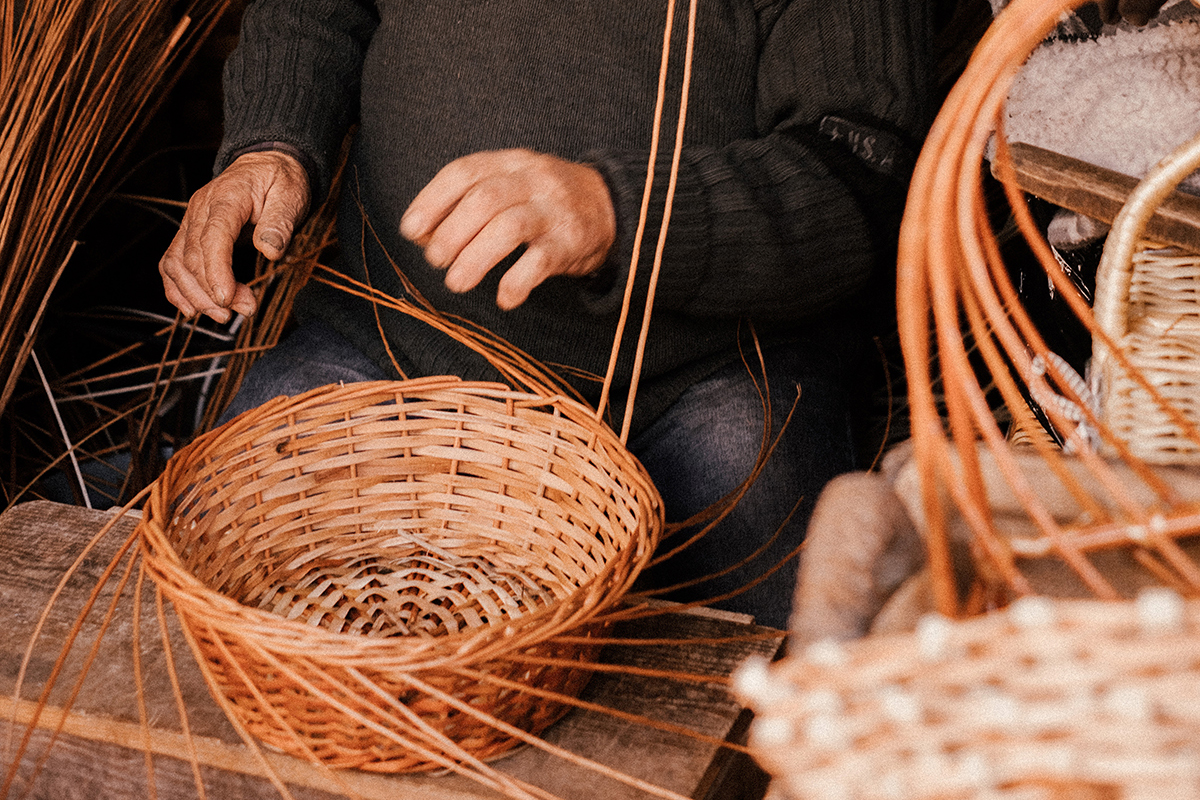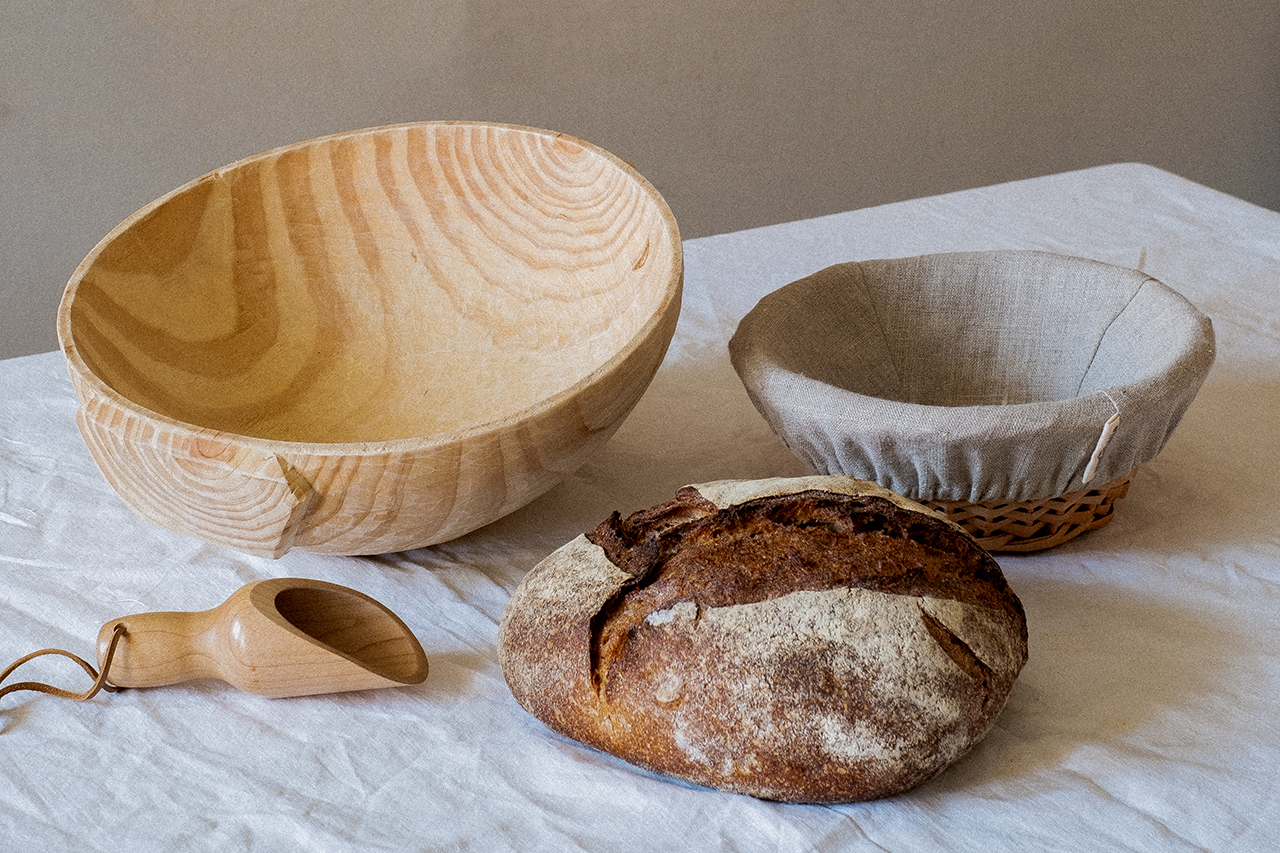Mais pão lento
MORE SLOW BREAD
Porquê que o pão lento é tão importante para a Mariamélia?
WHY IS NATURALLY LEAVENED BREAD SO IMPORTANTO TO MARIAMÉLIA?
A filosofia do pão de fermentação natural foi uma das ideias fundadoras do projeto e aquela por onde comecei o desenvolvimento informal de objetos com artesãos locais.
Slow and natural leavened bread was the motto for one of the most important ideas behind this project and the one that started the informal development of objects with local craftsmen.
Slow and natural leavened bread was the motto for one of the most important ideas behind this project and the one that started the informal development of objects with local craftsmen.

FOTO: FILIPA CRUZ
Como nasceram estes cestos e para que servem?
HOW WERE THEY DESIGNED AND WHAT’S THEIR FUNCTIONALITY?
Estes cestos servem para a última fase de fermentação do pão que é feito com fermento natural, servindo de recipiente e também de forma à massa. Chamam-se bannetons e podem ser feitos em diferentes materiais como vime ou cana. Os cestos de vime forrados a linho são tradicionais da padaria francesa e são utilizados para fermentações longas de massas mais hidratadas (com maior conteúdo de água), que precisam por isso de uma forma de sustentação da massa para que esta cresça e que seja ao mesmo tempo repirável. O linho absorve o excesso de humidade na superfície do pão, impedindo que a massa se agarre ao forro na altura de desenformar.
These baskets are used for the last phase of dough fermentation, the final rise. They serve as support and also help shape the dough. They're called bannetons and can be made of different materials such as cane or wicker. Linen lined wicker bannetons are traditional in french bakery and they're used in longer fermentation and for highly hydrated doughs, that need support that allows the dough to breathe through it. Linen absorbs the excess moisture that builds upon the dough's surface, preventing the dought to stick to the cloth when it comes out of the basket.
These baskets are used for the last phase of dough fermentation, the final rise. They serve as support and also help shape the dough. They're called bannetons and can be made of different materials such as cane or wicker. Linen lined wicker bannetons are traditional in french bakery and they're used in longer fermentation and for highly hydrated doughs, that need support that allows the dough to breathe through it. Linen absorbs the excess moisture that builds upon the dough's surface, preventing the dought to stick to the cloth when it comes out of the basket.

Porque são tão caros?
WHY ARE THESE BASKETS SO EXPENSIVE?
Por dois motivos: por um lado, são inteiramente feitos à mão por artesãos cesteiros e costureiras, com matérias-primas de origem nacional; por outro lado, além de serem feitos em pequena escala, são pagos valores justos a cada artesão pelo seu trabalho (e sempre que possível, estes valores são revistos em alta).
For two reasons: on one hand, they’re entirely handmade by basketry weavers and a seamstress small team with locally sourced materials, on the other hand, besides being produced on a small-scale, the artisans are paid fairly for their work, although I'm always keen to improve this.
For two reasons: on one hand, they’re entirely handmade by basketry weavers and a seamstress small team with locally sourced materials, on the other hand, besides being produced on a small-scale, the artisans are paid fairly for their work, although I'm always keen to improve this.

Para o que estou a contribuir com a compra de cada cesto?
WHAT AM I CONTRIBUTING FOR WHEN I PURCHASE ONE OF THESE BASKETS?
Cada cesto permite à Mariamélia continuar a colaboração com artesãos de pequena escala e criar mais projetos de colaboração de designers e makers com artífices e artesãos especializados, numa missão de revalorização cultural dos ofícios artesanais e semi-artesanais que existem no país.
Each purchase allows Mariamélia to proceed with the collaboration with small-scale artisans and craftsmen, in a mission to revalue the cultural role of artisanal and semi-artisanal craftsmanship in Portugal. It also supports the artisan's work so it can be maintained and developed for future generations.
Each purchase allows Mariamélia to proceed with the collaboration with small-scale artisans and craftsmen, in a mission to revalue the cultural role of artisanal and semi-artisanal craftsmanship in Portugal. It also supports the artisan's work so it can be maintained and developed for future generations.

Quem os faz e onde?
WHO MAKES THE BASKETS AND WHERE?
São feitos manualmente por vários artesãos cesteiros da zona de Braga, com vime de origem nacional (sempre que possível), em alguns acasos cultivado pelos próprios artesãos. O forro é feito em tecido 50% linho, 50% algodão, e embora o linho não seja nacional o tecido é fabricado na zona Norte do país. São costurados por uma micro-equipa de costureiras, na zona do grande Porto. As etiquetas em tecido de algodão são impressas digitalmente com tintas de base de água, em Barcelos.
These are totally handmade by several basketry weavers from Barcelos, a town near Braga. They’re handweaven with locally grown wicker (whenever that’s possible), and in some cases even grown by the weaver himself. The lining is made of 100% natural linen fabric, although the linen is not grown in Portugal, the fabric is made in textile factories in the North of Portugal. These are sewn by a micro-team of seamstresses in the Porto area. The cotton tags where printed with water-based inks in a local company in Barcelos.
These are totally handmade by several basketry weavers from Barcelos, a town near Braga. They’re handweaven with locally grown wicker (whenever that’s possible), and in some cases even grown by the weaver himself. The lining is made of 100% natural linen fabric, although the linen is not grown in Portugal, the fabric is made in textile factories in the North of Portugal. These are sewn by a micro-team of seamstresses in the Porto area. The cotton tags where printed with water-based inks in a local company in Barcelos.

Posso encomendar só um cesto?
CAN I ORDER ONLY ONE BASKET?
É possível encomendar apenas um cesto, tendo em conta que o valor dos portes de envio será o mesmo para um ou três cestos. A partir de 5 cestos aplicam-se descontos: contacta-me para obteres um orçamento personalizado consoante a quantidade e o destino de entrega.
You can order only one basket, although the price for shipping one or three baskets is the same. Starting with 10 baskets I can offer discounts, so contact me for a custom quote.
You can order only one basket, although the price for shipping one or three baskets is the same. Starting with 10 baskets I can offer discounts, so contact me for a custom quote.
Todas as fotografias neste artigo são da autoria da Matilde Viegas. As imagens no topo da página fazem parte da série Alento, um projeto da Matilde e da Mafalda Salgueiro sobre encontros em volta da comida que podem visitar aqui.
All photos in this post were taken by Matilde Viegas. The pictures at the top of the page are a part of Alento, a projet by Matilde and Mafalda Salgueiro about meetings around food that you can get
to know here.
All photos in this post were taken by Matilde Viegas. The pictures at the top of the page are a part of Alento, a projet by Matilde and Mafalda Salgueiro about meetings around food that you can get
to know here.

